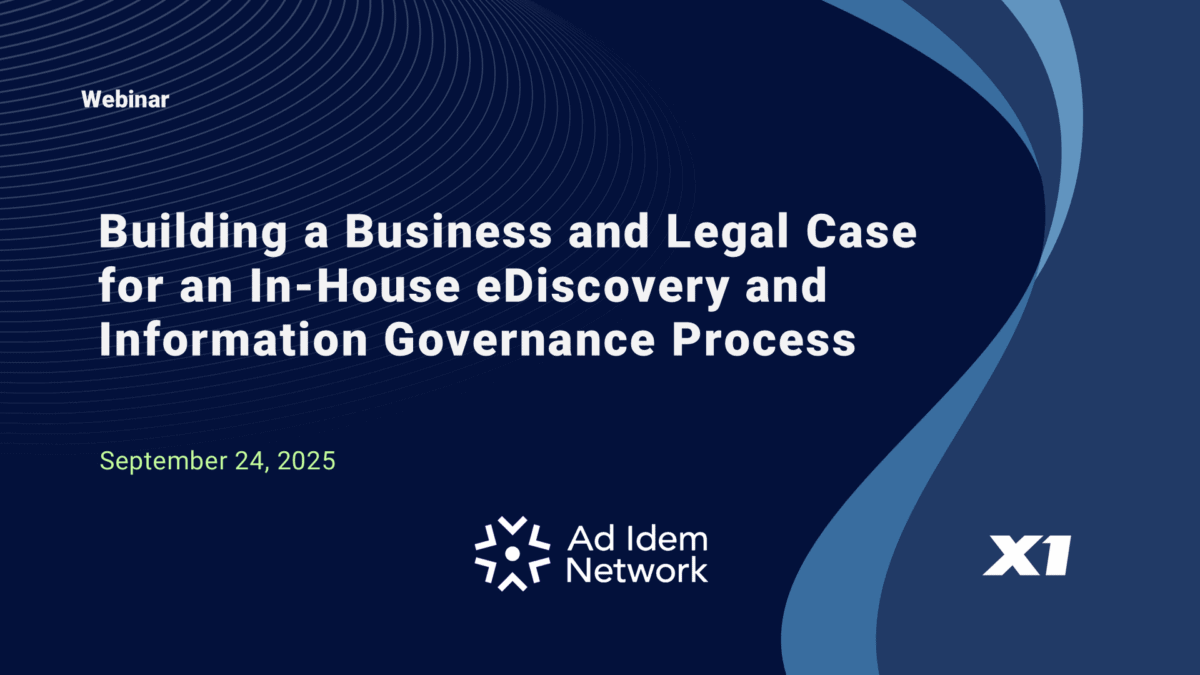By John Patzakis
In a recent webinar hosted by Ad Idem, a non-profit legal education provider for in-house counsel, attorneys Kelly Twigger and Eric Stansell offered a compelling roadmap for corporate legal departments looking to bring eDiscovery and information governance (InfoGov) in-house. Their insights cut through the complexity of traditional discovery models and emphasized the strategic, operational, and legal advantages of internalizing these processes. For legal professionals navigating mounting data volumes and rising litigation costs, their discussion provided both practical guidance and a call to rethink legacy workflows.
Eric Stansell, Senior Counsel for Discovery at Tyson Foods, opened with a candid reflection on how his role was created to address the company’s need for a more efficient eDiscovery program. He emphasized that building a business case for in-house capabilities starts with understanding the “why”—whether it’s cost savings, risk reduction, or process defensibility. Stansell emphasized that standardizing internal processes not only improves consistency but also enhances defensibility and reduces exposure by limiting data sprawl across external vendors.
Kelly Twigger — who is one of if not the top eDiscovery lawyer in the field in my opinion — built on Stansell’s narrative by stressing the importance of conducting a thorough assessment before launching any in-house initiative. She encouraged legal teams to break down business cases into manageable chunks, identifying quick wins such as revising email retention policies. Twigger noted that internal culture shifts and stakeholder alignment are just as critical as technology adoption. Her approach favors incremental change backed by measurable ROI, rather than sweeping transformations that risk overwhelming legal and IT teams.
Both speakers underscored the importance of engaging multiple stakeholders. Stansell shared Tyson’s experience with cross-functional collaboration, highlighting how legal, IT, audit, and compliance teams must be involved from the outset. As one example of such collaboration, Stansell noted that eDiscovery enterprise search and collection software procured by the legal team can also address key IT security priorities such as PII data audits and internal investigations.
Twigger also delivered a deep dive into the proportionality principles now codified under the Federal Rules of Civil Procedure, urging legal teams to build factual arguments early in the discovery process. She explained that proportionality isn’t just about cost—it’s about narrowing scope through targeted custodians, refined date ranges, and iterative search terms. Stansell added that understanding custodians’ roles and historical relevance can help avoid unnecessary data collection, further supporting proportionality claims in court.
One of the most pressing issues Twigger addressed was the evolving case law around hyperlinked files. She traced the trajectory from Nichols v. Noom, Inc.—where hyperlinks were deemed not attachments—to more recent rulings that treat them as discoverable content depending on technological capabilities. Twigger cited In re Uber and Young v. Salesforce to illustrate how courts are increasingly expecting parties to preserve and produce hyperlinked documents, especially when shared via chat platforms or collaborative tools.
Twigger warned that failing to understand your organization’s tech stack could lead to costly missteps. She recommended that in-house counsel proactively assess their systems—especially Microsoft 365 environments—to determine what’s feasible when it comes to hyperlink preservation and production. She also highlighted X1 Discovery’s capabilities, noting that X1’s software can automate the collection of contemporaneous versions of hyperlinked documents in M365, support targeted Teams chat collection as well as many other data sources, making X1 a valuable solution for defensible in-house eDiscovery.
In closing, both Twigger and Stansell made it clear that bringing eDiscovery and InfoGov in-house isn’t just a cost-cutting measure—it’s a strategic imperative. With the right mix of technology, process, and cross-functional collaboration, legal departments can gain control, reduce risk, and improve outcomes. Their insights serve as a blueprint for legal teams ready to evolve beyond reactive discovery and toward a proactive, integrated approach.
The recording of the webinar can be accessed here.
